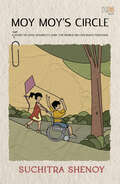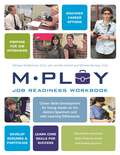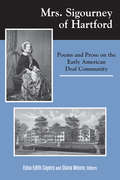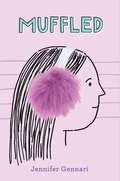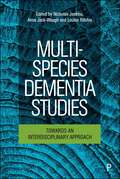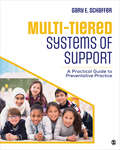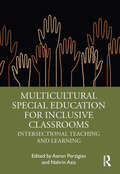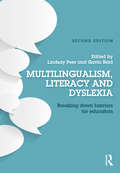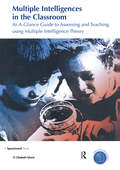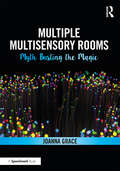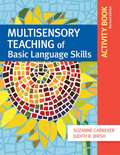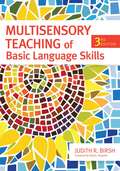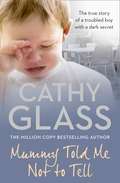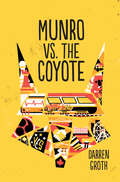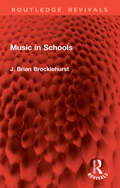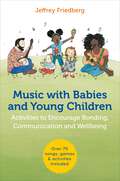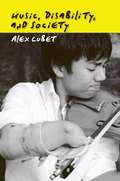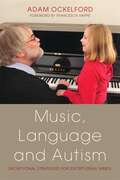- Table View
- List View
Moy Moy’s Circle: A True Story of Love, Disability and The World We Can Build Together
by Suchitra Shenoy'ABOUT LOVE AND IRRATIONAL COURAGE' - Rajmohan GandhiWhen Jo Chopra McGowan, an American woman living in India, adopts baby Moy Moy - born with multiple disabilities and given little chance of survival - she could not have foreseen how completely their lives would transform. What begins as an intimate journey between a mother and her child soon expands into something far greater: the birth of a pioneering organization: Latika.Latika doesn't just offer services; it changes lives. It supports children with developmental disabilities and their families while empowering its workforce - primarily young women who have known hardship intimately, and who are trained to become confident, skilled professionals. Over the course of more than twenty-five years, Latika has touched thousands of lives, delivering high-quality, affordable care infused with joy, compassion and dignity. Yet this is not simply the story of one child or one non-profit.Moy Moy's Circle is a powerful rendering of the resilience of the human spirit. It reveals what can happen when we listen to those the world often overlooks, how care can be an act of courage, how dignity is a right not a privilege, and how hope, paired with determination, can work quiet miracles. For anyone who has ever wondered how one life can make a difference, this deeply moving exploration by Suchitra Shenoy offers a luminous and lasting answer.
Mploy – A Job Readiness Workbook: Career Skills Development for Young Adults on the Autism Spectrum and with Learning Difficulties
by Carol Gray Michael P. Mcmanmon Michele Ramsay Jennifer KolarikThis self-guided workbook is suitable for young adults aged 16-26 with ASD (Autism Spectrum Disorder) or LD (Learning Differences), to teach the necessary skills for entering the workforce and forging a meaningful career path. Providing insight into a range of industries and workplace settings, this workbook will help you to support young people in choosing rewarding and successful careers. Detailing the College Internship Program's (CIP) successful Mploy program, the information in this book will help young adults to develop self-confidence and build social connections. Including activities and ready-to-use worksheets, this is a focused look at preparing for work. Key topics include: · Career assessments · Creating effective resumes/CVs · Interview skills · Employer expectations · Professional communication · Performance appraisals · Handling stress in the workplace · Social thinking · Executive functions in the workplace
Mrs. Sigourney of Hartford: Poems and Prose on the Early American Deaf Community
by Edna Edith Sayers Diana MooreLydia Huntley was born in 1791 in Norwich, CT, the only child of a poor Revolutionary war veteran. But her father's employer, a wealthy widow, gave young Lydia the run of her library and later sent her for visits to Hartford, CT. After teaching at her own school for several years in Norwich, Lydia returned to Hartford to head a class of 15 girls from the best families. Among her students was Alice Cogswell, a deaf girl soon to be famous as a student of Thomas Hopkins Gallaudet and Laurent Clerc. Lydia's inspiration came from a deep commitment to the education of girls and also for African American, Indian, and deaf children. She left teaching to marry Charles Sigourney, then turned to writing to support her family, publishing 56 books, 2,000 magazine articles, and popular poetry. Lydia Sigourney never abandoned her passion for deaf education, remaining a supporter of Gallaudet's school for the deaf until her death. Yet, her contributions to deaf education and her writing have been forgotten until now. All of Lydia Sigourney's of Lydia Sigourney's work on the nascent Deaf community is presented in this new volume. Her writing intertwines her mastery of the sentimentalism form popular in her day with her sharp insights on the best ways to educate deaf children. In the process, Mrs. Sigourney of Hartford reestablishes her rightful place in history.
Muffin the Fish: Targeting the f Sound (Speech Bubbles 1)
by Melissa PalmerMuffin is a quirky little fish full of fun ideas. What will he get up to next? This picture book targets the /f/ sound, and is part of Speech Bubbles 1, a series of picture books that target specific speech sounds within the story. The series can be used for children receiving speech therapy, for children who have a speech sound delay/disorder, or simply as an activity for children’s speech sound development and/or phonological awareness. They are ideal for use by parents, teachers or caregivers. Bright pictures and a fun story create an engaging activity perfect for sound awareness. Please see other titles in the series for stories targeting other speech sounds.
Muffled
by Jennifer GennariA young girl learns how to cope with her noise sensitivity and step outside of her comfort zone in this heartwarming middle grade novel that&’s perfect for fans of If This Were a Story and El Deafo.Ten-year-old Amelia does not like noise. From subway brakes to squeaky sneakers, she is sensitive to sound, just like her dad. Amelia has always worn noise-canceling headphones, but now that she&’s going into fifth grade, her parents want her to stop wearing them. To make matters worse, she must learn to play an instrument! Or, as Amelia sees it, make noise on purpose. To help Amelia cope, her father gives her a pair of earmuffs to wear instead. Even with her new earmuffs, Amelia struggles at school…until she gets partnered with Madge in music class. Madge is loud and bold and goofy—everything Amelia is not. And so Amelia is surprised when Madge wants to be friends. Still, it&’s not long though before Amelia&’s quiet nature clashes with Madge&’s loud personality. And when Madge disappears after an argument, Amelia fears Madge might be in trouble. If she&’s going to help her friend, she will have to find a way to let in the noisy world she&’s muffled for so long.
Multi-Species Dementia Studies: Towards an Interdisciplinary Approach
by Nicholas Jenkins, Anna Jack-Waugh and Louise RitchieDementia is one of the greatest challenges facing humanity in the 21st century. Responding to the global dementia challenge, however, affects more than humans alone. We live in a multi-species world but often think about dementia in mono-species ways. From the lab to the living room, other beings are “on the scene” and our relations with them affect how we understand, experience, and respond to dementia. Drawing on cutting-edge work across the social and biological sciences, this book offers readers the tools to respond to dementia in multi-species ways. By exploring a range of topics, from pathology to personhood, contributors highlight how thinking about dementia as a more-than-human phenomenon may enable new ways of responding to our global dementia challenge.
Multi-Tiered Systems of Support: A Practical Guide to Preventative Practice
by Gary E. SchafferMulti-Tiered Systems of Support: A Practical Guide to Preventative Practice, by Gary Schaffer, makes it easy to decipher this important framework for delivering evidence-based interventions to improve students’ learning, behavior, and social-emotional outcomes. This text focuses on the common elements of the intervention service delivery models comprising Multi-Tiered Systems of Support (MTSS) to offer step-by-step guidance for each stage of the process. Covering MTSS from a "whole child" perspective, Multi-Tiered Systems of Support empowers current and future educators to set up learners for the greatest success in school and beyond. This book simplifies the MTSS model using an overall analogy of the four basic steps to building a house. We start with the foundation as the history of MTSS, the walls as the four main intervention service delivery models, the framework as common components that link all delivery models, and then the roof that represents MTSS as a whole. Diagrams, checklists and flowcharts accompany each step of the MTSS model to organize and summarize the information on each model. Case studies offer practical, in-depth examples of implementation strategies across models within MTSS. Unique sections on data-based decision making and infusing culturally responsive practices into RTI, SWPBS, Social-Emotional RTI, and Suicide Prevention and Intervention offer readers ways to better adapt and refine their implementation of MTSS. Through this text, readers will have a convenient resource that will save them time locating information on interventions, measures of universal screening, and progress monitoring unique to each intervention service delivery model within MTSS.
Multi-Tiered Systems of Support: A Practical Guide to Preventative Practice
by Gary E. SchafferMulti-Tiered Systems of Support: A Practical Guide to Preventative Practice, by Gary Schaffer, makes it easy to decipher this important framework for delivering evidence-based interventions to improve students’ learning, behavior, and social-emotional outcomes. This text focuses on the common elements of the intervention service delivery models comprising Multi-Tiered Systems of Support (MTSS) to offer step-by-step guidance for each stage of the process. Covering MTSS from a "whole child" perspective, Multi-Tiered Systems of Support empowers current and future educators to set up learners for the greatest success in school and beyond. This book simplifies the MTSS model using an overall analogy of the four basic steps to building a house. We start with the foundation as the history of MTSS, the walls as the four main intervention service delivery models, the framework as common components that link all delivery models, and then the roof that represents MTSS as a whole. Diagrams, checklists and flowcharts accompany each step of the MTSS model to organize and summarize the information on each model. Case studies offer practical, in-depth examples of implementation strategies across models within MTSS. Unique sections on data-based decision making and infusing culturally responsive practices into RTI, SWPBS, Social-Emotional RTI, and Suicide Prevention and Intervention offer readers ways to better adapt and refine their implementation of MTSS. Through this text, readers will have a convenient resource that will save them time locating information on interventions, measures of universal screening, and progress monitoring unique to each intervention service delivery model within MTSS.
Multicultural Special Education for Inclusive Classrooms: Intersectional Teaching and Learning
by Aaron Perzigian Nahrin AzizThis book provides a comprehensive exploration of critical topics in multicultural special education. Filled with case studies, objectives, and summaries to support deeper learning, the chapters discuss privilege and power in K-12 school systems, effective and differentiated instruction, culturally competent IEPs and transition plans, and appropriate assessment. Drawing from seminal multicultural education and culturally sustaining pedagogies, this essential text helps educators develop the skills necessary to affirm and honor identities while meeting the instructional needs of culturally diverse students with disabilities.
Multilingualism, Literacy and Dyslexia: Breaking down barriers for educators
by Gavin Reid Lindsay PeerThis fully revised new edition provides advice on the identification, assessment and support of bilingual learners and assists practitioners in identifying the difference between literacy difficulties due to bilingualism or multilingualism and dyslexia. An essential text for staff development, it includes innovative approaches in technology and teaching programmes beneficial to multilingual learners and advice on learning additional languages. With contributions from experts from across the globe, this book will provide guidance on key themes, including: the assessment of multilingual learners the impact of dyslexia on bilingualism the literacy challenges facing learners from Indigenous cultures the role of the SENCO in identifying children with English as an additional language and Dyslexia the emotional needs of learners with bi/multilingualism and Dyslexia This book will provide guidance to anyone involved in literacy development and language learning. With the increase in international schools around the globe and the ever growing desire for parents to ensure that their children become proficient in English, this book will appeal to teachers, teaching assistants, specialists, and all other practitioners who work with bi/multilingual children.
Multiple Autisms: Spectrums of Advocacy and Genomic Science
by Jennifer S. SinghIs there a gene for autism? Despite a billion-dollar, twenty-year effort to find out—and the more elusive the answer, the greater the search seems to become—no single autism gene has been identified. In Multiple Autisms, Jennifer S. Singh sets out to discover how autism emerged as a genetic disorder and how this affects those who study autism and those who live with it. This is the first sustained analysis of the practices, politics, and meaning of autism genetics from a scientific, cultural, and social perspective.In 2004, when Singh began her research, the prevalence of autism was reported as 1 in 150 children. Ten years later, the number had jumped to 1 in 100, with the disorder five times more common in boys than in girls. Meanwhile the diagnosis changed to &“autistic spectrum disorders,&” and investigations began to focus more on genomics than genetics, less on single genes than on hundreds of interacting genes. Multiple Autisms charts this shift and its consequences through nine years of ethnographic observations, analysis of scientific and related literatures, and morethan seventy interviews with autism scientists, parents of children with autism, and people on the autism spectrum. The book maps out the social history of parental activism in autism genetics, the scientific optimism about finding a gene for autism and the subsequent failure, and the cost in personal and social terms of viewing and translating autism through a genomic lens.How is genetic information useful to people living with autism? By considering this question alongside the scientific and social issues that autism research raises, Singh&’s work shows us the true reach and implications of a genomic gaze.
Multiple Intelligences in the Classroom
by Elizabeth MorrisHolistic approach to understanding and celebrating all the ways in which a child is intelligent. Suitable for schools, support workers and families, this resource offers support to children on their learning journey.
Multiple Meanings in American Sign Language
by Brenda E. Cartwright Suellen J. BahledaThere are a variety of ways one can use this book to improve one's signing and interpreting skills. Teachers and students may choose to explore one particular unit or a variety of elements from different units. This book assists in developing and practicing a process for analyzing the meaning of specific English words and phrases so that one can create accurate equivalents in ASL. It is crucial that learners avoid the temptation to hurry through any exercise, even when a word or phrase seems easy or obvious. By taking the time to analyze and determine the meanings of the various words and phrases in the exercises within this book, a process for analyzing meaning emerges which serves as a foundation for analyzing the meaning of English words and phrases and translating this meaning accurately, efficiently and proficiently into ASL.
Multiple Multisensory Rooms: Myth Busting the Magic
by Joanna GraceMultisensory rooms are widely used across the country in schools, care settings, hospitals and homes. Even settings such as football stadiums and airports are installing multisensory environments. Nevertheless, a significant lack of effective research has led to a sense of unease around sensory rooms. This crucial book explores the use of multisensory rooms in order to ease that anxiety; taking the mystery out of multisensory rooms, and supporting the reader to reflect and make the most out of their space. Key features include: Guidance on creating sensory spaces on any budget, to suit any level of need. An overview of the history of multisensory rooms, and a detailed exploration of the actual way in which the rooms are used today. A framework for evaluating existing practices and equipment, in order to maximise the potential of the room. A focus on the practitioner as the most important piece of ‘equipment’ in any sensory room. Written by a leading sensory specialist in a fully accessible way, this book is an invaluable tool for anybody who uses, or is considering using, a multisensory room.
Multiple Sclerosis: Understanding the Cognitive Challenges
by Nicholas Larocca Rosalind KalbWritten by two clinical psychologists with contributions from two neuropsychologists -- each an MS specialist -- Multiple Sclerosis: Understanding the Cognitive Challenges answers all questions patients may have about their condition, including: A definition of cognition and discussion of the processes that underlie human thought The emotional and social impact of cognitive changes The neuropsychological evaluation of cognitive symptoms Detailed overview of treatment options Vignettes describing the real-life experiences of people with cognitive dysfunction Extensive references to the scientific literature Combining detailed, referenced advice with hands-on strategies for living, this is the only book to provide in-depth information about cognitive dysfunction. It will be an invaluable reference to patients, families, and caregivers, as well as to health professionals who care for people with MS.
Multisensory Teaching Of Basic Language Skills Activity Book
by Suzanne Carreker Judith R. BirshWith the new edition of this activity book--the companion to Judith Birsh's bestselling text, Multisensory Teaching of Basic Language Skills--students and practitioners will get the practice they need to use multisensory teaching effectively with students who have dyslexia and other learning disabilities. Ideal for both pre-service teacher education courses and in-service professional development, the activity book aligns with the third edition of the Multisensory Teaching textbook, so readers can easily use them in tandem.
Multisensory Teaching of Basic Language Skills (3rd Edition)
by Judith R. BirschAs new research shows how effective systematic and explicit teaching of language-based skills is for students with learning disabilities—along with the added benefits of multisensory techniques—discover the latest on this popular teaching approach with the third edition of this bestselling textbook. Adopted by colleges and universities across the country, this definitive core text is now fully revised and expanded with cutting-edge research and more on hot topics such as executive function, fluency, and adolescent literacy. The most comprehensive text available on multisensory teaching, this book shows preservice educators how to use specific multisensory approaches to dramatically improve struggling students' language skills and academic outcomes in elementary through high school.
Mummy Told Me Not to Tell: The True Story of a Troubled Boy with a Dark Secret
by Cathy GlassReece is the last of six siblings to be fostered. Having been in care for four months his aggressive and disruptive behaviour has seen him passed from carer to carer. Although only 7, he has been excluded from school, and bites people so often that his mother calls him 'Sharky'. Cathy wants to find the answers for Reece's distressing behaviour, but he has been sworn to secrecy by his mother, and will not tell them anything. As the social worker prepares for the final hearing, he finds five different files on Reece's family, and is incredulous that he had not been removed from them as a baby. When the darkest of family secrets is revealed to Cathy, Reece's behaviour suddenly starts to make sense, and together they can begin to rebuild his life.
Munro vs. the Coyote
by Darren GrothSince the sudden death of his younger sister, Evie, sixteen-year-old Munro Maddux has been having flashbacks and anger-management issues. He has a constant ache in his right hand. And there's a taunting, barking, biting voice he calls "the Coyote." Munro knows a six-month student exchange will not be the stuff of teenage dreams, but in Brisbane, he intends to move beyond his troubled past. It is there, at an assisted-living residence called Fair Go Community Village, that Munro discovers the Coyote can be silenced. Munro volunteers as a "Living Partner" and gets to know the team of residents he is assigned to. The burden Munro carries, however, is not so easily cast aside. When one of the team makes the decision to leave, the Coyote gets a new life. When a second resident is taken away, the specter of trauma and death looms larger than ever. Will Munro learn how to silence the voice? Or will the Coyote ultimately triumph?
Murphy's Boy: He Was a Frightened Boy Who Refused to Speak - Until a Teacher's Love Broke Through the Silence
by Torey L. HaydenHe sounded like a lost case right from the beginning. A fifteen year old boy who had not said a word since he was seven. And that wasn't the worst of it. When therapist Torey Hayden accepted this assignment others had long dismissed as futile, she knew she was in for a major challenge. But when she actually confronted Kevin, an institutionalized, retarded boy on the brink of manhood, who hid under tables, who feared highways and door hinges and spirals on notebooks and odd bits of string, who feared water too much to bathe and nakedness too much to change his clothes, she saw that bringing him back would take a miracle. And when the miracle happened, and Torey managed to penetrate Kevin's terrible silence, it was only to discover, lurking beneath a past littered with violence and mental cruelty, a dreadful secret, made all the worse by the bureaucracy that had recorded it, then filed it away.
Music in Schools (Routledge Revivals)
by J. Brian BrocklehurstFirst published in 1962, Music in Schools discusses all aspects of the teaching of singing in schools. The most effective methods of laying the foundations of musicianship are fully dealt with and ways are considered in which movements, speech, and simple instrumental playing can be used to develop children’s musical literacy, aural perception, and creative ability.Attention is given to the development of children’s taste for, and in, music (including jazz and popular music) and stress is laid on the importance of children as active participants in the appreciation lesson, not simply passive spectators. The place of instrumental music in schools is considered fully and methods of teaching the playing of percussion instruments (rhythmic and melodic), recorders, bamboo pipes, harmonicas, and melodicas are examined. Suggestions are made concerning the formation of school brass bands and piano, string and wind instrument classes; advice is also given on the training and conducting of school orchestras.Other subjects which receive attention include continuity in school music, the value of musical aptitude tests, the use of films and other visual aids, the provision of equipment for music rooms in schools and the place of music in the education of mentally and physically handicapped children.
Music with Babies and Young Children: Activities to Encourage Bonding, Communication and Wellbeing
by Jeffrey FriedbergFrom day one in a child's life, music is one of the most important things that can be used to help them grow and learn. Musical stimulation helps lay the foundations for a lifetime of skills, and this straightforward guide gives detailed advice on how to use music to help children from 0-5 years with common developmental challenges such as attachment and bonding, bedtime, tantrums and daily living skills, social skills, motor skills and school readiness. Combining cutting-edge research on brain development with proven strategies, this book helps with both typical and atypical issues in the earliest stages of a child's life. Friedberg lays out the musical parenting approach, where any adult can enhance children's lives through music. No prior music skill is necessary to use the musical parenting approach, making it an ideal resource for all parents, teachers and professionals to raise healthy, well-adjusted children in a creative and interactive manner.
Music, Disability, and Society
by Alex LubetMusical talent in Western culture is regarded as an extraordinary combination of technical proficiency and interpretative sensitivity. In Music, Disability, and Society, Alex Lubet challenges the rigid view of technical skill and writes about music in relation to disability studies. He addresses the ways in which people with disabilities are denied the opportunity to participate in music. Elaborating on the theory of "social confluence," Lubet provides a variety of encounters between disability and music to observe radical transformations of identity. Considering hand-injured and one-handed pianists; the impairments of jazz luminaries Django Reinhardt, Horace Parlan, and "Little" Jimmy Scott; and the "Blind Orchestra" of Cairo, he shows how the cultural world of classical music contrasts sharply with that of jazz and how musicality itself is regarded a disability in some religious contexts. Music, Disability, and Society also explains how language difference can become a disability for Asian students in American schools of music, limiting their education and careers. Lubet offers pungent criticism of the biases in music education and the music profession, going so far as to say that culture disables some performers by adhering to rigid notions of what a musician must look like, how music must be played, who may play it, and what (if any) is the legitimate place of music in society. In Music, Disability, and Society, he convincingly argues that where music is concerned, disability is a matter of culture, not physical impairment.
